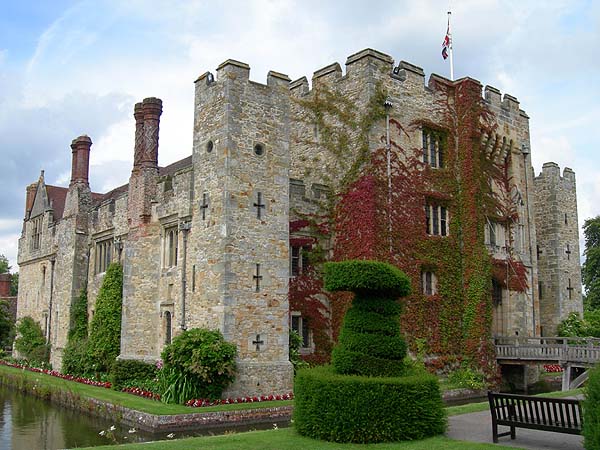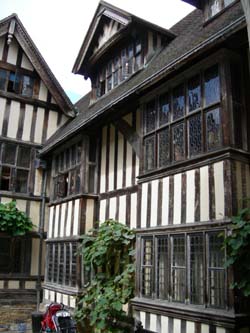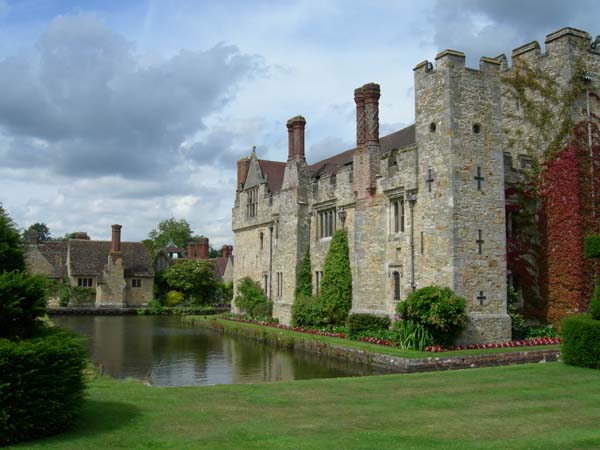Hever Castle: The Childhood Home of Anne Boleyn
by Tori V. Martínez
Mention British royal homes and most people think almost exclusively of the Queen's official royal residences -- Buckingham Palace, Windsor Castle and The Palace of Holyroodhouse -- or of private royal homes like Sandringham House and Clarence House. While these are all incredibly important and significant places, a slew of important historical residences once inhabited by royalty go almost unnoticed by both travelers and armchair tourists alike. Among these is the childhood home of one of the most memorable royal women in the history of the English Crown: Anne Boleyn.

Visitors to London can get to Hever Castle in about the same time it takes to travel from central London to Windsor Castle, and enjoy far better scenery along the way. A visit to Hever can also be a lot more gratifying to discerning travelers and royal history lovers than other royal homes, since it is generally less crowded and boasts a longer past than some of the relatively newer, more popular royal residences in and around London. It also provides a unique insight into the early life and personalitiy of its royal inhabitant.
Anne Boleyn's childhood home is tucked away near Edenbridge in the beautiful Kent countryside, which is justifiably referred to as England's garden. By train, the journey to Hever Castle shows off the green fields and expansive farms of Kent to their best advantage, while a car ride off the beaten track takes you through narrow country roads completely enveloped by trees. Once there, the initial approach to the castle itself strikes you with how perfectly it fulfills childhood ideals of the way a castle should look -- moated and crenellated, flanked by twin towers dotted with cross loops, and made complete by a wooden drawbridge and imposing portcullis. But the best part is this is no reproduction castle, it's the real thing. In fact, the most commanding part of the castle -- the gate house -- is much the same as when it was built as a defensive fortress by William de Hever, a sheriff during the reign of Edward I, around 1270. William's heirs continued to fortify the castle and it eventually came under various owners until it was purchased in 1451 by Anne Boleyn's great-grandfather, Sir Geoffrey Bullen (Boleyn). Geoffrey's increasing wealth and rise to prominence as Lord Mayor of London in 1459 allowed him to convert and expand the castle into a comfortable private residence. By 1505, Sir Thomas Boleyn had further expanded the castle and was living there with his wife Elizabeth and their three children, including Anne.
 Since Anne's birth year has never been confirmed, it's difficult to say for certain if she was born at Hever Castle. If she was born in 1501, as some scholars suggest, then it's more likely that she was born at the other family home, Blickling Hall in Norfolk. On the other hand, if she was born in 1507, as is also strongly suggested, then it would be possible that she was born at Hever. In any case, we do know for certain that Hever Castle was Anne's childhood home, although she spent a great deal of her young life elsewhere. She first left England in 1513 for the Netherlands, where she was placed in the court of the Archduchess Margaret of Austria, who was Regent of the Netherlands. By the fall of 1514, she was a lady-in-waiting at the court of the Queen of France -- Henry VIII's sister, Princess Mary. She stayed on as lady-in-waiting to Mary's successor, Queen Claude, until 1522, when she returned to England. Even after more than eight years away from home, Anne returned not to Hever Castle, but to the Court of Henry VIII in the service of Queen Katherine. Finally, in 1523, she returned to live at Hever Castle when she was exiled from the English Court following her thwarted attempt to marry Lord Henry Percy. Since Anne's birth year has never been confirmed, it's difficult to say for certain if she was born at Hever Castle. If she was born in 1501, as some scholars suggest, then it's more likely that she was born at the other family home, Blickling Hall in Norfolk. On the other hand, if she was born in 1507, as is also strongly suggested, then it would be possible that she was born at Hever. In any case, we do know for certain that Hever Castle was Anne's childhood home, although she spent a great deal of her young life elsewhere. She first left England in 1513 for the Netherlands, where she was placed in the court of the Archduchess Margaret of Austria, who was Regent of the Netherlands. By the fall of 1514, she was a lady-in-waiting at the court of the Queen of France -- Henry VIII's sister, Princess Mary. She stayed on as lady-in-waiting to Mary's successor, Queen Claude, until 1522, when she returned to England. Even after more than eight years away from home, Anne returned not to Hever Castle, but to the Court of Henry VIII in the service of Queen Katherine. Finally, in 1523, she returned to live at Hever Castle when she was exiled from the English Court following her thwarted attempt to marry Lord Henry Percy.
 When she returned to Court in 1525, Anne was still in the early stages of the drama that would consume the rest of her life and end in her execution in 1536. Not surprisingly, Hever Castle played an important role in that drama. Although Anne spent a great deal of time at Court, Hever was still her home and Henry VIII almost certainly visited Anne there in his quest to gain her as his mistress. The story from here needs little retelling, but the long and drawn out courting of Anne by Henry did prove beneficial for the Boleyn family and left an indirect mark on Hever Castle. The royal favor granted Anne with the title of Marchioness of Pembroke in 1532, her father with the title Earl of Ormonde and Wiltshire in 1529 and, by connection, her brother George became Viscount Rochford. Anne's sister Mary received a £100 a year pension and Mary's son -- widely believed to be Henry's bastard -- was given an excellent education. All of this good fortune and prosperity certainly helped to improve and distinguish Hever Castle, especially when Anne's marriage to Henry made it the family home of the Queen.
When she returned to Court in 1525, Anne was still in the early stages of the drama that would consume the rest of her life and end in her execution in 1536. Not surprisingly, Hever Castle played an important role in that drama. Although Anne spent a great deal of time at Court, Hever was still her home and Henry VIII almost certainly visited Anne there in his quest to gain her as his mistress. The story from here needs little retelling, but the long and drawn out courting of Anne by Henry did prove beneficial for the Boleyn family and left an indirect mark on Hever Castle. The royal favor granted Anne with the title of Marchioness of Pembroke in 1532, her father with the title Earl of Ormonde and Wiltshire in 1529 and, by connection, her brother George became Viscount Rochford. Anne's sister Mary received a £100 a year pension and Mary's son -- widely believed to be Henry's bastard -- was given an excellent education. All of this good fortune and prosperity certainly helped to improve and distinguish Hever Castle, especially when Anne's marriage to Henry made it the family home of the Queen.
It was probably just as well for Anne that she spent much so much time away from home, particularly if her life there was as uninviting as both her living quarters and reportedly frosty family life seem to suggest. By all accounts, the interior of the castle had been made into a very comfortable Tudor manor house, but it was still relatively small, especially when you consider that the expansive Tudor outbuildings were only added in the early 20th century. In fact, once you step inside Hever Castle, any sense of awe you may have experienced on the outside is somewhat diminished as you find yourself ducking to avoid hitting your head on the top of the low doorways. Certainly, grand public rooms like the Long Gallery are something special, but it was, after all, a castle, and impressive public areas often came at the expense of the private rooms -- especially the private room of a mere daughter. As a result, Anne's bedroom, which can be seen by visitors to Hever Castle, was most certainly cramped and small. As for the outside of the castle, it's difficult to say what the castle grounds looked like in Anne's time, but there's no doubt that they didn't include the magnificent 20th century gardens or the Yew Maze, Splashing Water Maze and Adventure Playground. Nevertheless, Anne managed to amuse herself during the time she did spend at Hever Castle, likely by refining her talent for music or reading from her personal Books of Hours, which are on display there today.
 Of course, all of this marvelous good fortune came to an abrupt end when Anne was executed on May 19, 1536. Two days earlier, Anne's brother had been executed after being found guilty of committing adultery with Anne (false though those charges were). His death effectively ended the continuation of the peerage conferred on his father at the height of Henry's infatuation with Anne. The line went permanently extinct when Anne's father died in 1539. With his death, Hever Castle passed to the Crown. Ironically, the castle was given to Henry VIII's fourth wife, Anne of Cleves, in 1540 as part of her divorce settlement. Anne owned the castle until her death in 1557, although how much time she actually spent there is unknown. Of course, all of this marvelous good fortune came to an abrupt end when Anne was executed on May 19, 1536. Two days earlier, Anne's brother had been executed after being found guilty of committing adultery with Anne (false though those charges were). His death effectively ended the continuation of the peerage conferred on his father at the height of Henry's infatuation with Anne. The line went permanently extinct when Anne's father died in 1539. With his death, Hever Castle passed to the Crown. Ironically, the castle was given to Henry VIII's fourth wife, Anne of Cleves, in 1540 as part of her divorce settlement. Anne owned the castle until her death in 1557, although how much time she actually spent there is unknown.
For the next three and a half centuries, Hever Castle went through a series of owners and an eventual decline that ended in 1903, when it was purchased by the American millionaire, William Waldorf Astor. Astor went about meticulously restoring Hever, carefully maintaining the original external appearance and staying as true as possible on the interior to the Tudor style. Although many of the rooms were converted into more modern living areas, others, like Anne's bedroom, were kept largely intact, and all the rooms today include art and artifacts either from Tudor times or related to the Boleyn family and Henry VIII and his six wives. Outside the castle, Astor improved and expanded the grounds, including the creation of a 35 acre lake, a walking path called "Anne Boleyn's Walk," and several beautiful gardens dotted with classical Italian sculptures. Anne's spirit must approve of these modern additions because her ghost reportedly still wanders the gardens and bridges surrounding the castle.
Because of the size and space limitations of the original castle, Astor also expanded Hever by adding the 100 room Tudor Village to accommodate guests. The result is surprisingly authentic and charming and the Village today serves as a conference center complete with 20 bedrooms, a dining room for 64 guests, boardroom for 25 people and presentation room for 60. More importantly for travelers, the castle has been open to the public since 1983 and is very family friendly, which might actually be considered a downside to some visitors. But if you can look beyond some of the more "touristy" elements and rampaging children -- perhaps by escaping to the Rose Garden -- Hever Castle is a must-visit destination for all history lovers.

More Information:
We regret that we no longer have the resources to maintain up-to-date links and/or hours and pricing details for the various sites and attractions listed on this website. For more information about the location(s) listed above, please use your favorite search engine or visit Wikipedia.
Tori V. Martínez is a writer and freelance public relations professional who spends as much time as possible researching and writing on her favorite subject -- history. Several years ago, Tori eschewed the life of a full-time career woman to travel and live around the world, particularly in Britain, where she spent considerable time exploring and researching historic destinations. At the moment, she is living in the US with her husband -- a Spaniard she met in England -- and is happily writing for a variety of online and print publications.
Article © 2005 Tori V. Martínez
Hever Castle photos © 2007 by Patrick D. Allen
Portraits of Anne Boleyn and Henry VIII by Hans Holbein the Younger, courtesy of Wikipedia.org
|
